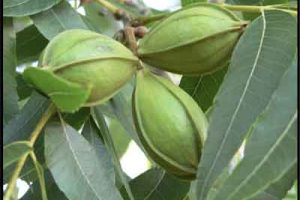Carya illinoinensis
Origin
Native to North America and now grown commercially in many countries worldwide. There is evidence the nuts have been eaten by mankind for more than 10,000 years. Carya consists of about 20 species.
Climate
It is an adaptable temperate species that can also grow in cooler sub-tropical climates, with genetic variations reflecting different climate zones for the original introductions. Some varieties can tolerate winter temperatures of less than -20°C. Natural precipitation range is 450-1600mm pa with drier conditions in summer and autumn preferred. Mature trees can withstand some flooding and drought but yield will be compromised
Plant Description
Large slow-growing but long-lived deciduous diploid trees, up to 20m high in WA conditions, with a rounded canopy. Different varieties can be broadly spreading to columnar. They have large, deep taproots and a spread of lateral roots up to twice the spread of the tree. The pinnately compound leaves have 9-13 lanceolate leaflets which increase in area from basal to terminal.
Relatives
Juglandaceae Family, related to walnuts and hickories.
Soils
Deep, fertile well-drained alluvial soils or sandy loams, pH 5.5-6.5, are best. Pecans need relatively high amounts of major and minor nutrients and trace elements, especially zinc.
Propagation
Pecans do not come true from seed and seedlings may not be matched to the local environment for optimal productivity. However open-pollinated seed can be used for rootstocks, as patch budding and grafting is the main technique used in commercial orchards. Commercially, the variety Apache is used for pecan rootstocks.
Cultivars
Reasonably self-pollinating cvs suitable for smaller spaces are Western Schley and Shoshonii. Appropriate pollinator cvs will need to be planted for many others to assure adequate and reliable production. ‘Appropriate’ means that the dates for the shedding of pollen on one tree matches the flowering time for the other. There are charts for different cultivars to facilitate this. Also, cultivars from North America come from a range of climate zones, so it is important to try to obtain a variety that originated from a suitable climate. So, you must do some homework.
Flowering and Pollination
Trees are monoecious but hetero-dichogamous. All trees have both male and female flowers, but the male catkins rarely shed pollen when the female flowers are receptive, which encourages cross-pollination. Staminate flowers are borne on pairs of 3-stalked catkins and pistillate flowers occur at the tip of current season’s shoots. Pollination is by wind. Almost all cvs need some winter chilling to flower, 300-1600hrs.
Cultivation
They should be planted in a sunny site for good photosynthetic activity. Growth and yield will be enhanced with regular applications of a complete fertilizer. Zinc deficiencies are common and need to be managed, usually by foliar sprays. Irrigation will be necessary to give good yields.
Wind Tolerance
Moderate tolerance and sometimes used as windbreaks. If planted fairly closely, they can be managed as a large hedge. Branches are prone to breaking in the wind.
Pruning
Pruning should ensure good light penetration throughout the tree. Selection and training to achieve branches with wide strong crotch angles should be undertaken. Corrective pruning is mainly done in summer on mature trees
The Fruit
It is a drupe-like nut, 2.5-4cm long, occurring in clusters of 2-10 with a dehiscent husk that splits along preformed sutures to reveal the elongated thin-shelled reddish-brown nut. Kernels are 2-lobed, similar to walnuts. Nuts in shell can be kept in a dry place for several months. Kernels contain about 70% oils, 14% carbohydrates, 10% fibre and good levels of Fe and Mg. Most of the oils are monounsaturated (oleic acid).
Fruit Production and Harvesting
Seedlings have a long period of juvenility. Grafted trees begin to bear from the 4th year but may take several more years to reach full production. Yields are often erratic with alternate bearing behaviour, whereas better cvs and those more suited to the local environment can be more regular. Collection is usually after dehisced nuts have fallen from the tree.
Fruit Uses
Most pecan kernels are used in processed forms such as bread, muffins, pies, ice cream, yoghurt, confectionary and breakfast cereal. They are also consumed fresh.
Pests and Diseases
Birds may well be the biggest pest, with netting needed to ensure the crop is not plundered.
Comments
Growers with limited space should endeavour to obtain cvs that are sufficiently self-fertile to avoid having to plant a second pollinator. Alternatively, an appropriate scion can be grafted on to the one tree. Lower-chill cvs are needed for flowering in much of the south west of WA, especially Perth and surrounds.
